Beekeeping, also known as apiculture, is the practice of maintaining bee colonies, usually in hives, by humans. This ancient practice, dating back to at least 15,000 years ago, is conducted for the production of honey, beeswax, and other products. It also plays a crucial role in pollinating flowers, contributing significantly to our ecosystem.
However, beekeeping is not without its risks. Bees are known to defend their colonies fiercely when they perceive a threat, which can result in painful, and sometimes dangerous, stings. Therefore, safety is of paramount importance in beekeeping. It is essential to have the right protective gear to prevent bee stings and ensure a safe and productive beekeeping experience.
Among the various protective gear used in beekeeping, bee suits are arguably the most important. They are designed to protect the beekeeper from bee stings while allowing them to work comfortably in the apiary. This article will delve into the importance of bee suits, the different types available, and how to choose the right one.
Our Top Bee Suit Picks
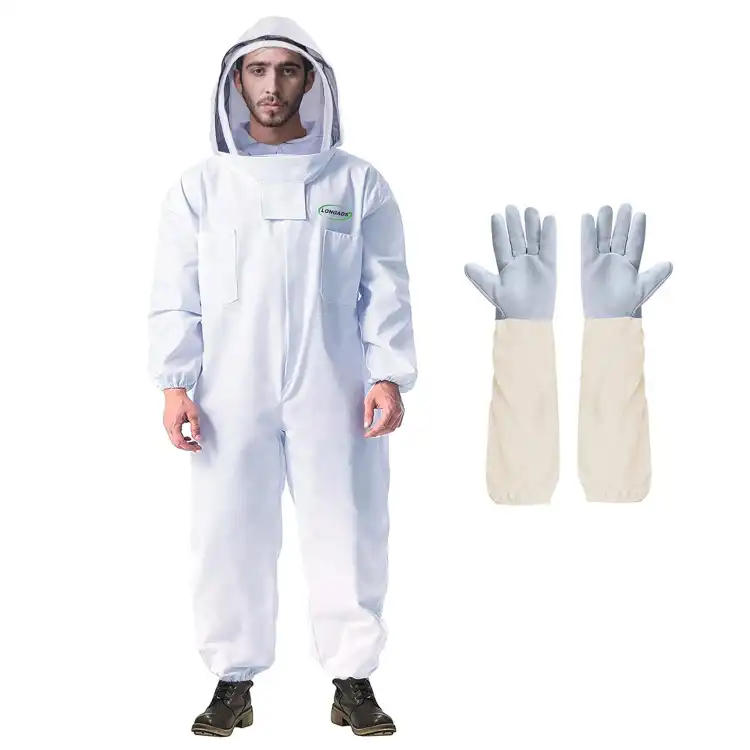
LONGADS Professional Bee Suit
Check on AmazonKey Specs:
- Material: Premium protective fabric
- Gloves: Full-length goatskin
- Ventilation: Ventilated design for comfort
- Veil: Detachable fencing veil
- Weight: Approx. 2 lbs
The LONGADS Professional Bee Suit is a top-tier choice for beekeepers prioritizing safety and comfort. The suit’s premium fabric offers excellent protection, ensuring you’re shielded from stings while tending to your hives. The goatskin gloves provide flexibility and durability, ideal for handling tools. What sets this suit apart is the ventilated design, which keeps you comfortable even during long hours in the field. The detachable veil and elastic bands ensure a snug, secure fit, keeping bees at bay.
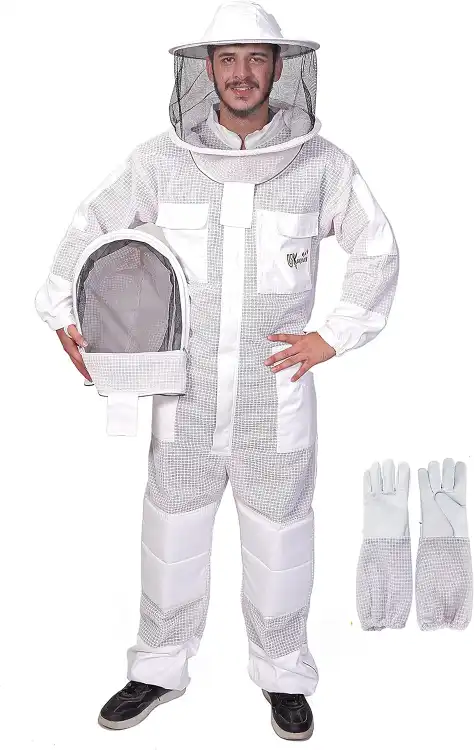
USKEEPERS 3 Layer Bee Suit
Check on AmazonKey Specs:
- Material: Three layers of Polly cotton mesh fabric
- Veils: Includes both Fencing Veil and Round Veil
- Zippers: Strong YKK brass zippers
- Pockets: Eight deep, Velcro-secured pockets
- Gloves: Goatskin gloves with ventilated cuffs
The USKEEPERS 3-Layer Ultra Ventilated Bee Suit is an exceptional choice for both novice and seasoned beekeepers. The suit’s three-layer mesh fabric ensures excellent ventilation, keeping you cool and comfortable during long hours in the hive. What I love most is the detachable veils—both the fencing and round veil offer clear visibility while maintaining full protection. The elastic wrists, ankles, and Velcro-fastened cuffs guarantee no bees get inside. Plus, the YKK brass zippers ensure durability, even with heavy use.
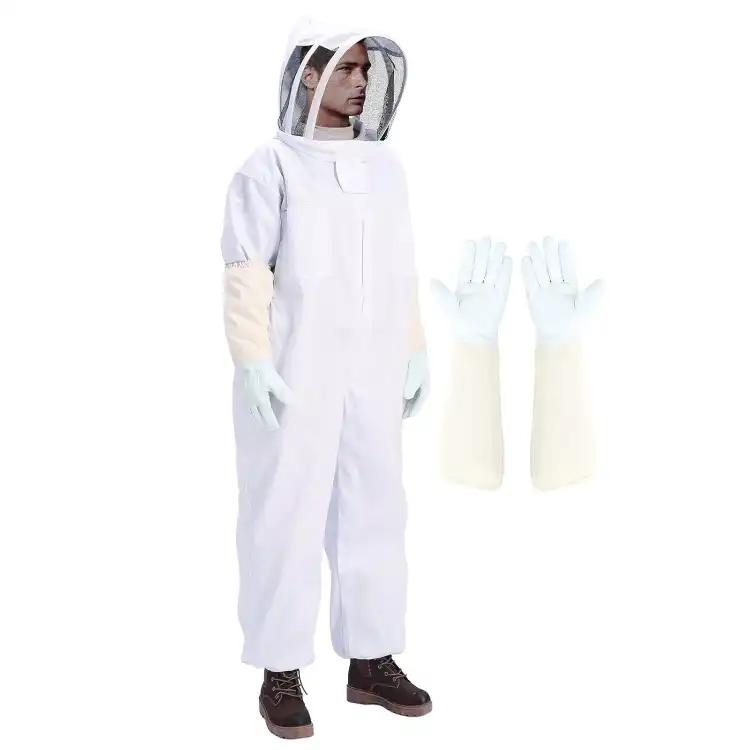
BEEKINGDOM Bee Keeper Suit
Check on AmazonKey Specs:
- Material: Breathable cotton-blend fabric
- Gloves: Goatskin gloves for arm protection
- Veil: Detachable 3-layer fencing veil with 270° visibility
- Adjustability: Velcro cuffs and waist for a snug fit
- Suit Size: Fits XXL, ideal for 5’11”-6’3″ height
The BEEKINGDOM Upgrade Bee Keeper Suit offers incredible protection with its specially designed fabric that acts as an armor against bee stings. The Goatskin gloves are a standout feature, providing flexibility and durability while keeping your arms safe. I particularly appreciate the detachable fencing veil with its ultra-fine mesh, offering an unobstructed 270° view. The breathable cotton-blend fabric ensures optimal ventilation, keeping me comfortable during long sessions in the hive. The suit’s adjustable cuffs and waist offer a custom, snug fit.
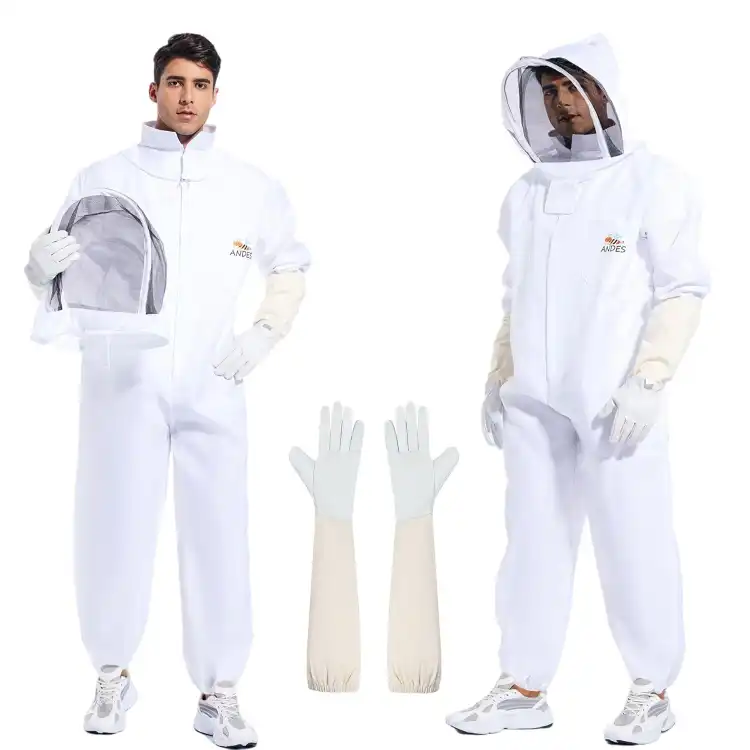
ANDES Bee Suit
Check on AmazonKey Specs:
- Material: 65% cotton, 35% polyester blend
- Gloves: Durable goatskin gloves for protection
- Veil: Detachable fencing veil with spacious interior
- Fit: Designed to fit both men and women
- Package: Includes suit and gloves
The ANDES Bee Suit offers comprehensive protection with its poly-cotton blend fabric (65% cotton, 35% polyester) that shields me from stings while still providing breathability. The included goatskin gloves offer both durability and flexibility, which is essential when handling tools in the hive. I appreciate the detachable veil, which gives me a wide, clear field of vision. The suit is not only protective but also incredibly comfortable, making it ideal for both beginners and experienced beekeepers.
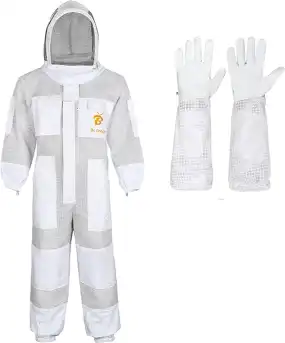
Be Noble Heavy Duty Protective Bee Suit
Check on AmazonKey Specs:
- Fabric: 3-layer cotton for sting protection
- Closure: Elastic at wrists and ankles with Velcro veil
- Ventilation: Breathable fabric for enhanced airflow
- Storage: Multiple deep pockets for tools and equipment
- Fit: Unisex design with adjustable waist and cuffs
The Be Noble 3-Layer Beekeeping Suit is an absolute game-changer for both new and seasoned beekeepers. The multi-layer design ensures top-notch sting protection, while still offering incredible breathability thanks to its lightweight, ventilated cotton fabric. I appreciate the elastic closures at the wrists and ankles, which prevent any gaps where bees could sneak in. The suit is not only protective but also flexible, allowing easy movement while handling hives. Plus, the deep pockets are perfect for storing tools on the go.
Understanding the Risks of Beekeeping
Beekeeping, while rewarding, comes with its share of potential dangers. The most obvious risk is bee stings. While a single bee sting is merely painful for most people, multiple stings can lead to serious health complications. Moreover, some people are allergic to bee stings, and for them, even a single sting can trigger a potentially life-threatening allergic reaction.
Additionally, bees can transmit diseases. Beekeepers can contract American Foulbrood, a bacterial disease that can be transferred to humans through contact with infected bees or contaminated equipment. Therefore, it is crucial to have protective gear when handling bees or their hives.
Protective gear plays a vital role in mitigating the risks associated with beekeeping. It provides a physical barrier between the beekeeper and the bees, reducing the chances of stings. Moreover, it also helps prevent the spread of diseases by minimizing direct contact with the bees and their hives.
The Role of Bee Suits in Beekeeping
Bee suits are a critical part of a beekeeper’s protective gear. They are designed to cover the entire body, including the head, hands, and feet, providing comprehensive protection against bee stings. The suits are typically made of thick material that bees cannot sting through, and they have tight seals at the wrists and ankles to prevent bees from getting inside.
Moreover, bee suits are not just about protection. They are also designed to be comfortable to wear for extended periods. They usually have ventilation to prevent overheating and are flexible enough to allow the beekeeper to perform necessary tasks without hindrance.
The importance of bee suits in beekeeping cannot be overstated. They provide the first line of defense against bee stings, allowing beekeepers to work with their hives with confidence. Without a good bee suit, beekeeping can be a risky endeavor.
Different Types of Bee Suits
There are several types of bee suits available, each with its own advantages and disadvantages. Full bee suits provide the most comprehensive protection, covering the entire body from head to toe. They are ideal for working in areas with high bee activity or for people who are particularly sensitive to bee stings.
Bee jackets are a less comprehensive option, covering only the upper body. They are easier to put on and take off than full suits and are often more comfortable to wear in hot weather. However, they provide less protection and are best suited for tasks with a lower risk of stings, such as hive inspection.
Bee veils protect only the face and neck, but they are the most comfortable and convenient option. They are ideal for quick tasks or for working with less aggressive bee species. However, they should be used in conjunction with other protective clothing to prevent stings on other parts of the body.
Materials Used in Bee Suits
Bee suits are made from various materials, each with its own set of characteristics. Cotton bee suits are comfortable and breathable, making them ideal for hot weather. However, they are not as sting-proof as other materials and may not be suitable for working with aggressive bee species.
Polyester bee suits are more sting-proof than cotton ones, but they are also less breathable. They are a good choice for working in cooler weather or with more aggressive bees. However, they can be uncomfortable to wear for extended periods in hot weather.
Ventilated bee suits are a relatively new innovation in beekeeping gear. They are made from a special material that is both sting-proof and breathable. These suits are the most comfortable option for working in hot weather, but they are also the most expensive.
Key Features to Look for in a Bee Suit
When choosing a bee suit, there are several key features to consider. The thickness of the suit is one of the most important factors. A thicker suit provides better protection against stings, but it can also be hotter and less comfortable to wear. Therefore, it’s crucial to strike a balance between protection and comfort.
Ventilation is another important feature to consider. A well-ventilated suit can help keep you cool in hot weather, making your beekeeping tasks more comfortable. Look for suits with ventilation panels in areas where heat tends to build up, such as the back and underarms.
Zippers and seals are also crucial features of a bee suit. They should be robust and easy to use, and they should provide a tight seal to prevent bees from getting inside the suit. Look for suits with double zippers for added protection and convenience.
Importance of Suit Size and Fit
Getting the right size and fit is crucial when buying a bee suit. A suit that is too tight can be uncomfortable and restrict your movement, making it difficult to perform your beekeeping tasks. On the other hand, a suit that is too loose can provide gaps where bees can get in, reducing your protection.
To measure for a bee suit, you will need to measure your chest, waist, inseam, and arm length. Most bee suit manufacturers provide sizing charts that you can use to find the right size based on your measurements. Remember to allow for some extra room for comfort and ease of movement.
A proper fit is not just about size, though. The suit should also have a good seal at the wrists and ankles to prevent bees from getting inside. Look for suits with elasticated cuffs and ankles, or with adjustable straps for a better fit.
Gloves and Boots: Essential Add-ons
Gloves and boots are essential add-ons to your bee suit. They provide protection for your hands and feet, which are particularly vulnerable to bee stings. There are several types of gloves available, including leather gloves, nitrile gloves, and ventilated gloves. Choose the type that provides the best balance of protection and dexterity for your needs.
Boots are also crucial for beekeeping. They protect your feet from stings and keep your feet dry and comfortable. Look for boots that are easy to put on and take off, have a good grip, and are tall enough to overlap with your bee suit for a good seal.
Remember, gloves and boots should be used in conjunction with a bee suit for comprehensive protection. They should also be cleaned and maintained regularly to keep them in good condition and ensure they provide the best protection.
How to Properly Wear a Bee Suit
Wearing a bee suit properly is crucial for your protection. Start by putting on your bee suit, making sure to zip it up completely and secure all seals. Then put on your gloves, making sure they overlap with the sleeves of your suit. Finally, put on your boots, making sure they overlap with the legs of your suit.
It’s important to check your suit for any gaps or holes where bees could get in. Pay particular attention to the seals at the wrists and ankles, and the area around the zipper. If you find any gaps or holes, repair them before using the suit.
There are some common mistakes to avoid when wearing a bee suit. One is not securing all the seals, which can allow bees to get inside the suit. Another is not checking the suit for damage before use, which can compromise your protection. Finally, avoid wearing dark or bright colors under your suit, as they can attract bees.
Maintaining and Cleaning Your Bee Suit
Maintaining and cleaning your bee suit is crucial to ensure it provides the best protection. Most bee suits can be machine washed, but check the manufacturer’s instructions to be sure. Use a mild detergent and avoid using bleach or fabric softener, as they can damage the suit’s material and seals.
After washing, hang your suit to dry. Avoid using a dryer, as the heat can shrink the suit and damage the seals. Once the suit is dry, check it for any damage and repair any holes or tears before storing it.
Store your bee suit in a cool, dry place, away from direct sunlight. Avoid folding the suit, as this can crease the material and damage the seals. Instead, hang it up or roll it loosely. Regularly check your stored suit for any signs of damage or infestation by pests.
Price Range and Where to Buy
The price of bee suits can vary widely, depending on the type, material, and brand. Full bee suits are the most expensive, with prices ranging from around $100 to over $300. Bee jackets and veils are less expensive, with prices typically ranging from around $50 to $150.
Bee suits can be purchased from a variety of places. Specialty beekeeping stores are a good place to start, as they often have a wide selection and knowledgeable staff. Online retailers like Amazon also have a wide range of bee suits, often at competitive prices. However, be sure to check the reviews and ratings before making a purchase.
When buying a bee suit, remember that price is not the only factor to consider. The suit’s material, features, and fit are also crucial. It’s often worth paying a bit more for a suit that provides better protection and comfort.
Reviews of Top Bee Suits
There are many bee suits on the market, and choosing the right one can be challenging. To help you make an informed decision, we have reviewed some of the top-rated bee suits in each category.
For full bee suits, the Ultra Breeze Beekeeping Suit is a top choice. It is made from a ventilated fabric that provides excellent protection and comfort. It also features durable zippers and a well-designed hood. However, it is on the expensive side.
For bee jackets, the Humble Bee 220 Polycotton Beekeeping Jacket is a great option. It is made from a blend of cotton and synthetic fibers for a good balance of protection and breathability. It also features a detachable hood and robust zippers. It is reasonably priced and highly rated by users.
For bee veils, the Natural Apiary Apiarist Beekeeping Veil is a top pick. It is made from a lightweight mesh material that provides good visibility and protection. It also features an elasticated bottom for a secure fit. It is affordable and highly rated by users.
Safety Tips Beyond the Bee Suit
While a bee suit is a crucial part of beekeeping safety, there are other safety practices to keep in mind. Always approach your hives calmly and slowly to avoid agitating the bees. Use a smoker to calm the bees before opening the hive. Always have an epinephrine autoinjector (EpiPen) on hand in case of severe allergic reactions to bee stings.
Additional safety gear can also be useful. A bee brush can help you gently remove bees from your suit or equipment. A hive tool can help you safely open and inspect your hives. A bee smoker can help calm the bees and reduce the chances of stings.
Remember, safety should always be your top priority when beekeeping. Always wear your bee suit and other protective gear, follow safe beekeeping practices, and be prepared for emergencies.
Conclusion
Bee suits play a crucial role in beekeeping safety. They provide a physical barrier between the beekeeper and the bees, reducing the chances of stings. They also help prevent the spread of diseases by minimizing direct contact with the bees and their hives.
Choosing the right bee suit can be challenging, but it’s worth the effort. Consider factors like the type of suit, the material, the features, the fit, and the price. Remember to also consider additional protective gear like gloves and boots, and to follow safe beekeeping practices.
With the right bee suit and safety practices, you can enjoy the rewarding practice of beekeeping with confidence and peace of mind.
FAQs
What is a bee suit?
A bee suit is a full-body suit designed to protect beekeepers from bee stings. It covers the entire body, including the head, hands, and feet, and is made from a material that bees cannot sting through.
Why is a bee suit important?
A bee suit is important because it provides the first line of defense against bee stings. It allows beekeepers to work with their hives with confidence, knowing they are protected.
What are the different types of bee suits?
There are several types of bee suits, including full bee suits, bee jackets, and bee veils. Full bee suits provide the most comprehensive protection, while bee jackets and veils are less comprehensive but more convenient and comfortable to wear.
What is a bee suit made of?
Bee suits can be made from various materials, including cotton, polyester, and ventilated fabric. Each material has its own set of characteristics, including its level of protection, comfort, and breathability.
How do I choose the right bee suit?
To choose the right bee suit, consider factors like the type of suit, the material, the features, the fit, and the price. Also, consider your own needs and preferences, such as your level of sensitivity to bee stings and the climate in which you will be working.
